Future of Sports: Trends and Challenges
VerifiedAdded on 2020/04/01
|12
|5109
|50
AI Summary
This assignment delves into the multifaceted future of sports, examining influential trends such as technological integration (e.g., e-sports), urbanization's impact on sports participation, and ethical dilemmas facing athletes, owners, and organizations. It also analyzes challenges in sports management, including facility development and maintaining fan engagement. The analysis draws upon provided research articles to support insights into the dynamic world of sports.
Contribute Materials
Your contribution can guide someone’s learning journey. Share your
documents today.
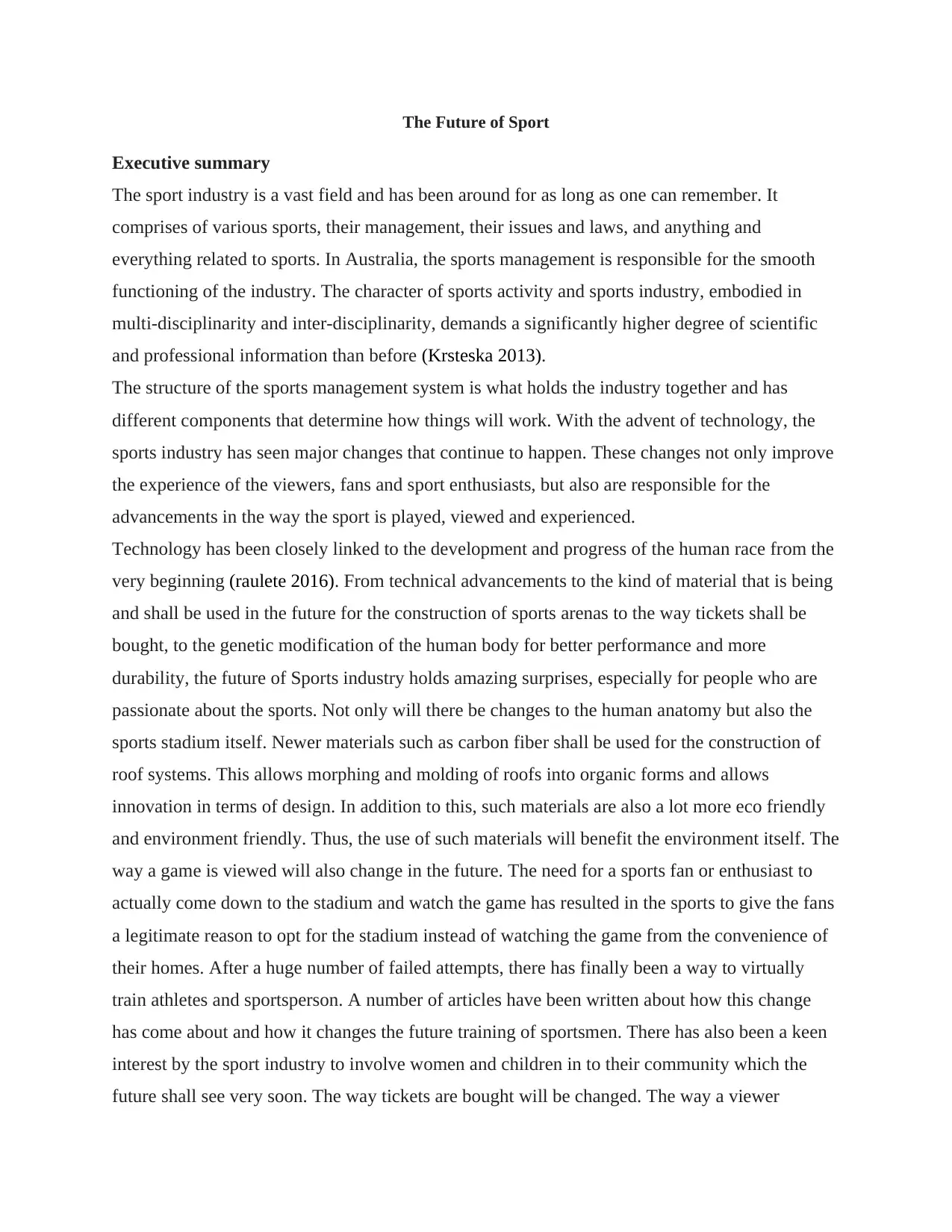
The Future of Sport
Executive summary
The sport industry is a vast field and has been around for as long as one can remember. It
comprises of various sports, their management, their issues and laws, and anything and
everything related to sports. In Australia, the sports management is responsible for the smooth
functioning of the industry. The character of sports activity and sports industry, embodied in
multi-disciplinarity and inter-disciplinarity, demands a significantly higher degree of scientific
and professional information than before (Krsteska 2013).
The structure of the sports management system is what holds the industry together and has
different components that determine how things will work. With the advent of technology, the
sports industry has seen major changes that continue to happen. These changes not only improve
the experience of the viewers, fans and sport enthusiasts, but also are responsible for the
advancements in the way the sport is played, viewed and experienced.
Technology has been closely linked to the development and progress of the human race from the
very beginning (raulete 2016). From technical advancements to the kind of material that is being
and shall be used in the future for the construction of sports arenas to the way tickets shall be
bought, to the genetic modification of the human body for better performance and more
durability, the future of Sports industry holds amazing surprises, especially for people who are
passionate about the sports. Not only will there be changes to the human anatomy but also the
sports stadium itself. Newer materials such as carbon fiber shall be used for the construction of
roof systems. This allows morphing and molding of roofs into organic forms and allows
innovation in terms of design. In addition to this, such materials are also a lot more eco friendly
and environment friendly. Thus, the use of such materials will benefit the environment itself. The
way a game is viewed will also change in the future. The need for a sports fan or enthusiast to
actually come down to the stadium and watch the game has resulted in the sports to give the fans
a legitimate reason to opt for the stadium instead of watching the game from the convenience of
their homes. After a huge number of failed attempts, there has finally been a way to virtually
train athletes and sportsperson. A number of articles have been written about how this change
has come about and how it changes the future training of sportsmen. There has also been a keen
interest by the sport industry to involve women and children in to their community which the
future shall see very soon. The way tickets are bought will be changed. The way a viewer
Executive summary
The sport industry is a vast field and has been around for as long as one can remember. It
comprises of various sports, their management, their issues and laws, and anything and
everything related to sports. In Australia, the sports management is responsible for the smooth
functioning of the industry. The character of sports activity and sports industry, embodied in
multi-disciplinarity and inter-disciplinarity, demands a significantly higher degree of scientific
and professional information than before (Krsteska 2013).
The structure of the sports management system is what holds the industry together and has
different components that determine how things will work. With the advent of technology, the
sports industry has seen major changes that continue to happen. These changes not only improve
the experience of the viewers, fans and sport enthusiasts, but also are responsible for the
advancements in the way the sport is played, viewed and experienced.
Technology has been closely linked to the development and progress of the human race from the
very beginning (raulete 2016). From technical advancements to the kind of material that is being
and shall be used in the future for the construction of sports arenas to the way tickets shall be
bought, to the genetic modification of the human body for better performance and more
durability, the future of Sports industry holds amazing surprises, especially for people who are
passionate about the sports. Not only will there be changes to the human anatomy but also the
sports stadium itself. Newer materials such as carbon fiber shall be used for the construction of
roof systems. This allows morphing and molding of roofs into organic forms and allows
innovation in terms of design. In addition to this, such materials are also a lot more eco friendly
and environment friendly. Thus, the use of such materials will benefit the environment itself. The
way a game is viewed will also change in the future. The need for a sports fan or enthusiast to
actually come down to the stadium and watch the game has resulted in the sports to give the fans
a legitimate reason to opt for the stadium instead of watching the game from the convenience of
their homes. After a huge number of failed attempts, there has finally been a way to virtually
train athletes and sportsperson. A number of articles have been written about how this change
has come about and how it changes the future training of sportsmen. There has also been a keen
interest by the sport industry to involve women and children in to their community which the
future shall see very soon. The way tickets are bought will be changed. The way a viewer
Secure Best Marks with AI Grader
Need help grading? Try our AI Grader for instant feedback on your assignments.
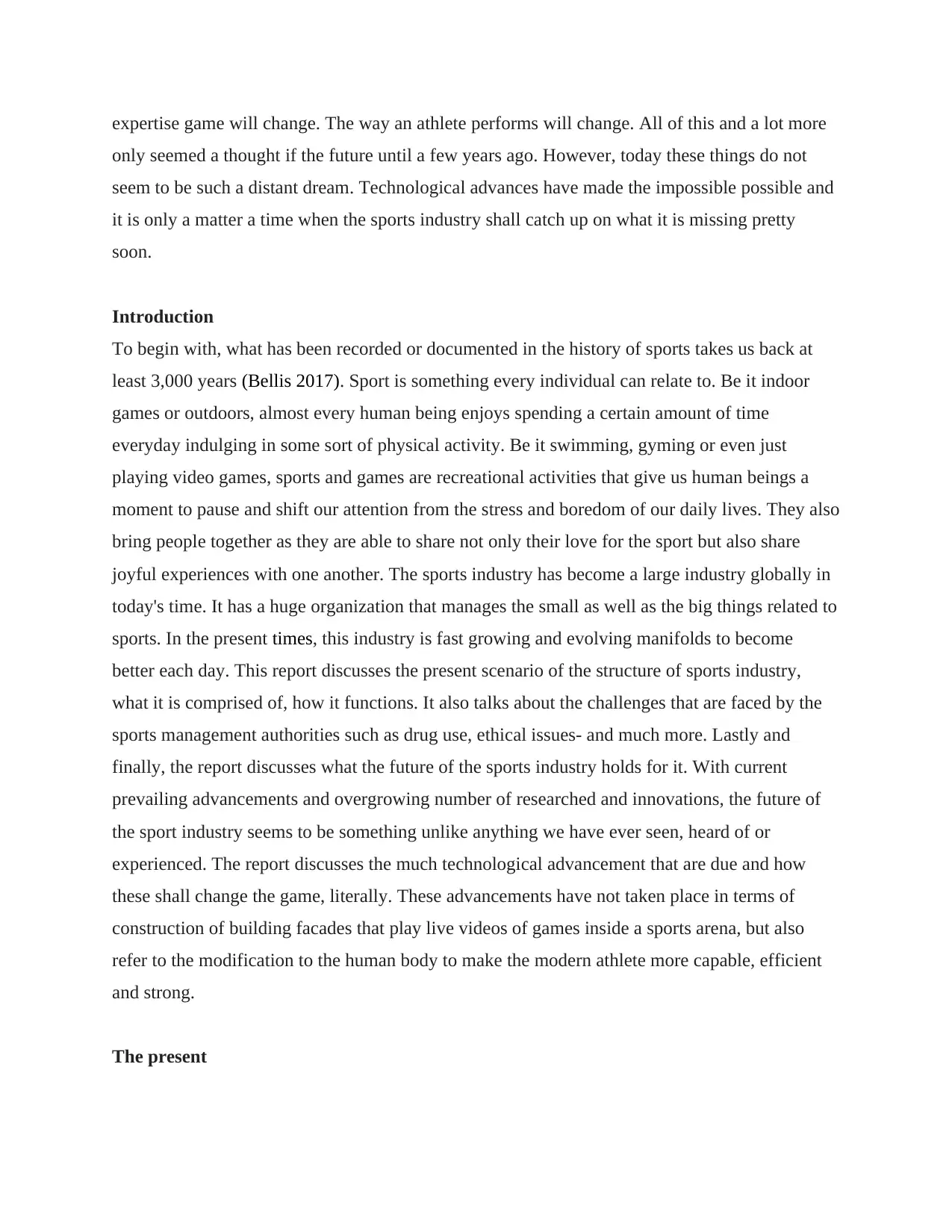
expertise game will change. The way an athlete performs will change. All of this and a lot more
only seemed a thought if the future until a few years ago. However, today these things do not
seem to be such a distant dream. Technological advances have made the impossible possible and
it is only a matter a time when the sports industry shall catch up on what it is missing pretty
soon.
Introduction
To begin with, what has been recorded or documented in the history of sports takes us back at
least 3,000 years (Bellis 2017). Sport is something every individual can relate to. Be it indoor
games or outdoors, almost every human being enjoys spending a certain amount of time
everyday indulging in some sort of physical activity. Be it swimming, gyming or even just
playing video games, sports and games are recreational activities that give us human beings a
moment to pause and shift our attention from the stress and boredom of our daily lives. They also
bring people together as they are able to share not only their love for the sport but also share
joyful experiences with one another. The sports industry has become a large industry globally in
today's time. It has a huge organization that manages the small as well as the big things related to
sports. In the present times, this industry is fast growing and evolving manifolds to become
better each day. This report discusses the present scenario of the structure of sports industry,
what it is comprised of, how it functions. It also talks about the challenges that are faced by the
sports management authorities such as drug use, ethical issues- and much more. Lastly and
finally, the report discusses what the future of the sports industry holds for it. With current
prevailing advancements and overgrowing number of researched and innovations, the future of
the sport industry seems to be something unlike anything we have ever seen, heard of or
experienced. The report discusses the much technological advancement that are due and how
these shall change the game, literally. These advancements have not taken place in terms of
construction of building facades that play live videos of games inside a sports arena, but also
refer to the modification to the human body to make the modern athlete more capable, efficient
and strong.
The present
only seemed a thought if the future until a few years ago. However, today these things do not
seem to be such a distant dream. Technological advances have made the impossible possible and
it is only a matter a time when the sports industry shall catch up on what it is missing pretty
soon.
Introduction
To begin with, what has been recorded or documented in the history of sports takes us back at
least 3,000 years (Bellis 2017). Sport is something every individual can relate to. Be it indoor
games or outdoors, almost every human being enjoys spending a certain amount of time
everyday indulging in some sort of physical activity. Be it swimming, gyming or even just
playing video games, sports and games are recreational activities that give us human beings a
moment to pause and shift our attention from the stress and boredom of our daily lives. They also
bring people together as they are able to share not only their love for the sport but also share
joyful experiences with one another. The sports industry has become a large industry globally in
today's time. It has a huge organization that manages the small as well as the big things related to
sports. In the present times, this industry is fast growing and evolving manifolds to become
better each day. This report discusses the present scenario of the structure of sports industry,
what it is comprised of, how it functions. It also talks about the challenges that are faced by the
sports management authorities such as drug use, ethical issues- and much more. Lastly and
finally, the report discusses what the future of the sports industry holds for it. With current
prevailing advancements and overgrowing number of researched and innovations, the future of
the sport industry seems to be something unlike anything we have ever seen, heard of or
experienced. The report discusses the much technological advancement that are due and how
these shall change the game, literally. These advancements have not taken place in terms of
construction of building facades that play live videos of games inside a sports arena, but also
refer to the modification to the human body to make the modern athlete more capable, efficient
and strong.
The present
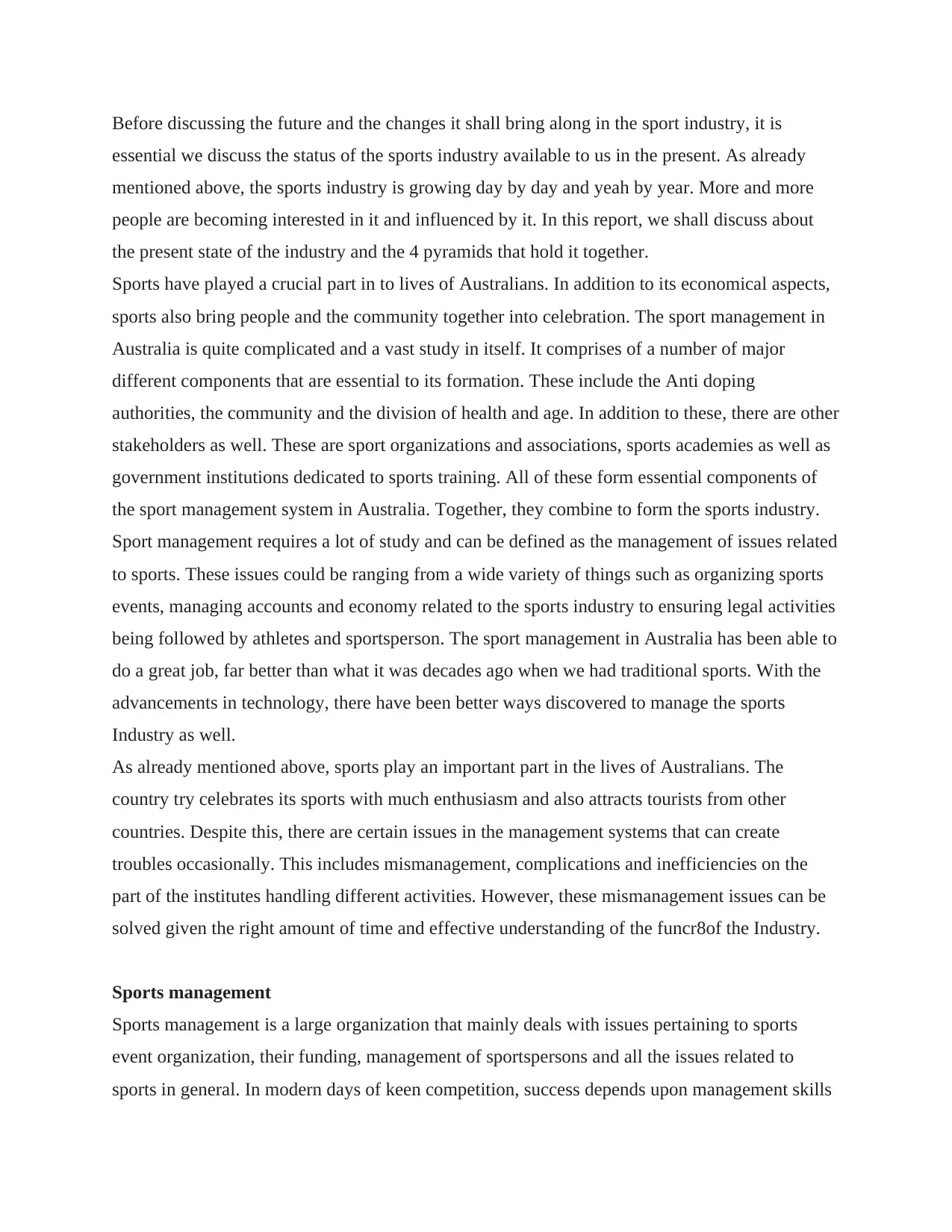
Before discussing the future and the changes it shall bring along in the sport industry, it is
essential we discuss the status of the sports industry available to us in the present. As already
mentioned above, the sports industry is growing day by day and yeah by year. More and more
people are becoming interested in it and influenced by it. In this report, we shall discuss about
the present state of the industry and the 4 pyramids that hold it together.
Sports have played a crucial part in to lives of Australians. In addition to its economical aspects,
sports also bring people and the community together into celebration. The sport management in
Australia is quite complicated and a vast study in itself. It comprises of a number of major
different components that are essential to its formation. These include the Anti doping
authorities, the community and the division of health and age. In addition to these, there are other
stakeholders as well. These are sport organizations and associations, sports academies as well as
government institutions dedicated to sports training. All of these form essential components of
the sport management system in Australia. Together, they combine to form the sports industry.
Sport management requires a lot of study and can be defined as the management of issues related
to sports. These issues could be ranging from a wide variety of things such as organizing sports
events, managing accounts and economy related to the sports industry to ensuring legal activities
being followed by athletes and sportsperson. The sport management in Australia has been able to
do a great job, far better than what it was decades ago when we had traditional sports. With the
advancements in technology, there have been better ways discovered to manage the sports
Industry as well.
As already mentioned above, sports play an important part in the lives of Australians. The
country try celebrates its sports with much enthusiasm and also attracts tourists from other
countries. Despite this, there are certain issues in the management systems that can create
troubles occasionally. This includes mismanagement, complications and inefficiencies on the
part of the institutes handling different activities. However, these mismanagement issues can be
solved given the right amount of time and effective understanding of the funcr8of the Industry.
Sports management
Sports management is a large organization that mainly deals with issues pertaining to sports
event organization, their funding, management of sportspersons and all the issues related to
sports in general. In modern days of keen competition, success depends upon management skills
essential we discuss the status of the sports industry available to us in the present. As already
mentioned above, the sports industry is growing day by day and yeah by year. More and more
people are becoming interested in it and influenced by it. In this report, we shall discuss about
the present state of the industry and the 4 pyramids that hold it together.
Sports have played a crucial part in to lives of Australians. In addition to its economical aspects,
sports also bring people and the community together into celebration. The sport management in
Australia is quite complicated and a vast study in itself. It comprises of a number of major
different components that are essential to its formation. These include the Anti doping
authorities, the community and the division of health and age. In addition to these, there are other
stakeholders as well. These are sport organizations and associations, sports academies as well as
government institutions dedicated to sports training. All of these form essential components of
the sport management system in Australia. Together, they combine to form the sports industry.
Sport management requires a lot of study and can be defined as the management of issues related
to sports. These issues could be ranging from a wide variety of things such as organizing sports
events, managing accounts and economy related to the sports industry to ensuring legal activities
being followed by athletes and sportsperson. The sport management in Australia has been able to
do a great job, far better than what it was decades ago when we had traditional sports. With the
advancements in technology, there have been better ways discovered to manage the sports
Industry as well.
As already mentioned above, sports play an important part in the lives of Australians. The
country try celebrates its sports with much enthusiasm and also attracts tourists from other
countries. Despite this, there are certain issues in the management systems that can create
troubles occasionally. This includes mismanagement, complications and inefficiencies on the
part of the institutes handling different activities. However, these mismanagement issues can be
solved given the right amount of time and effective understanding of the funcr8of the Industry.
Sports management
Sports management is a large organization that mainly deals with issues pertaining to sports
event organization, their funding, management of sportspersons and all the issues related to
sports in general. In modern days of keen competition, success depends upon management skills
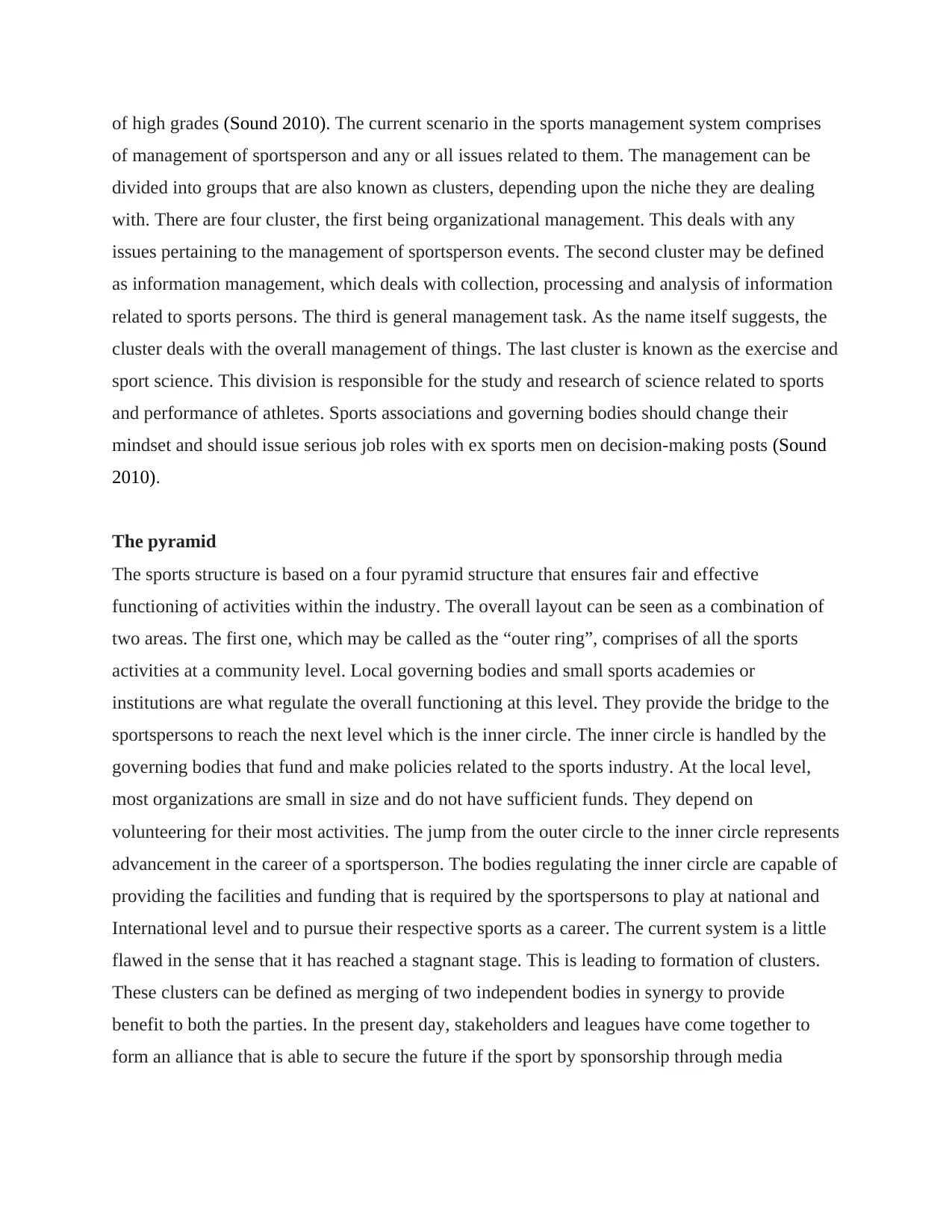
of high grades (Sound 2010). The current scenario in the sports management system comprises
of management of sportsperson and any or all issues related to them. The management can be
divided into groups that are also known as clusters, depending upon the niche they are dealing
with. There are four cluster, the first being organizational management. This deals with any
issues pertaining to the management of sportsperson events. The second cluster may be defined
as information management, which deals with collection, processing and analysis of information
related to sports persons. The third is general management task. As the name itself suggests, the
cluster deals with the overall management of things. The last cluster is known as the exercise and
sport science. This division is responsible for the study and research of science related to sports
and performance of athletes. Sports associations and governing bodies should change their
mindset and should issue serious job roles with ex sports men on decision-making posts (Sound
2010).
The pyramid
The sports structure is based on a four pyramid structure that ensures fair and effective
functioning of activities within the industry. The overall layout can be seen as a combination of
two areas. The first one, which may be called as the “outer ring”, comprises of all the sports
activities at a community level. Local governing bodies and small sports academies or
institutions are what regulate the overall functioning at this level. They provide the bridge to the
sportspersons to reach the next level which is the inner circle. The inner circle is handled by the
governing bodies that fund and make policies related to the sports industry. At the local level,
most organizations are small in size and do not have sufficient funds. They depend on
volunteering for their most activities. The jump from the outer circle to the inner circle represents
advancement in the career of a sportsperson. The bodies regulating the inner circle are capable of
providing the facilities and funding that is required by the sportspersons to play at national and
International level and to pursue their respective sports as a career. The current system is a little
flawed in the sense that it has reached a stagnant stage. This is leading to formation of clusters.
These clusters can be defined as merging of two independent bodies in synergy to provide
benefit to both the parties. In the present day, stakeholders and leagues have come together to
form an alliance that is able to secure the future if the sport by sponsorship through media
of management of sportsperson and any or all issues related to them. The management can be
divided into groups that are also known as clusters, depending upon the niche they are dealing
with. There are four cluster, the first being organizational management. This deals with any
issues pertaining to the management of sportsperson events. The second cluster may be defined
as information management, which deals with collection, processing and analysis of information
related to sports persons. The third is general management task. As the name itself suggests, the
cluster deals with the overall management of things. The last cluster is known as the exercise and
sport science. This division is responsible for the study and research of science related to sports
and performance of athletes. Sports associations and governing bodies should change their
mindset and should issue serious job roles with ex sports men on decision-making posts (Sound
2010).
The pyramid
The sports structure is based on a four pyramid structure that ensures fair and effective
functioning of activities within the industry. The overall layout can be seen as a combination of
two areas. The first one, which may be called as the “outer ring”, comprises of all the sports
activities at a community level. Local governing bodies and small sports academies or
institutions are what regulate the overall functioning at this level. They provide the bridge to the
sportspersons to reach the next level which is the inner circle. The inner circle is handled by the
governing bodies that fund and make policies related to the sports industry. At the local level,
most organizations are small in size and do not have sufficient funds. They depend on
volunteering for their most activities. The jump from the outer circle to the inner circle represents
advancement in the career of a sportsperson. The bodies regulating the inner circle are capable of
providing the facilities and funding that is required by the sportspersons to play at national and
International level and to pursue their respective sports as a career. The current system is a little
flawed in the sense that it has reached a stagnant stage. This is leading to formation of clusters.
These clusters can be defined as merging of two independent bodies in synergy to provide
benefit to both the parties. In the present day, stakeholders and leagues have come together to
form an alliance that is able to secure the future if the sport by sponsorship through media
Secure Best Marks with AI Grader
Need help grading? Try our AI Grader for instant feedback on your assignments.
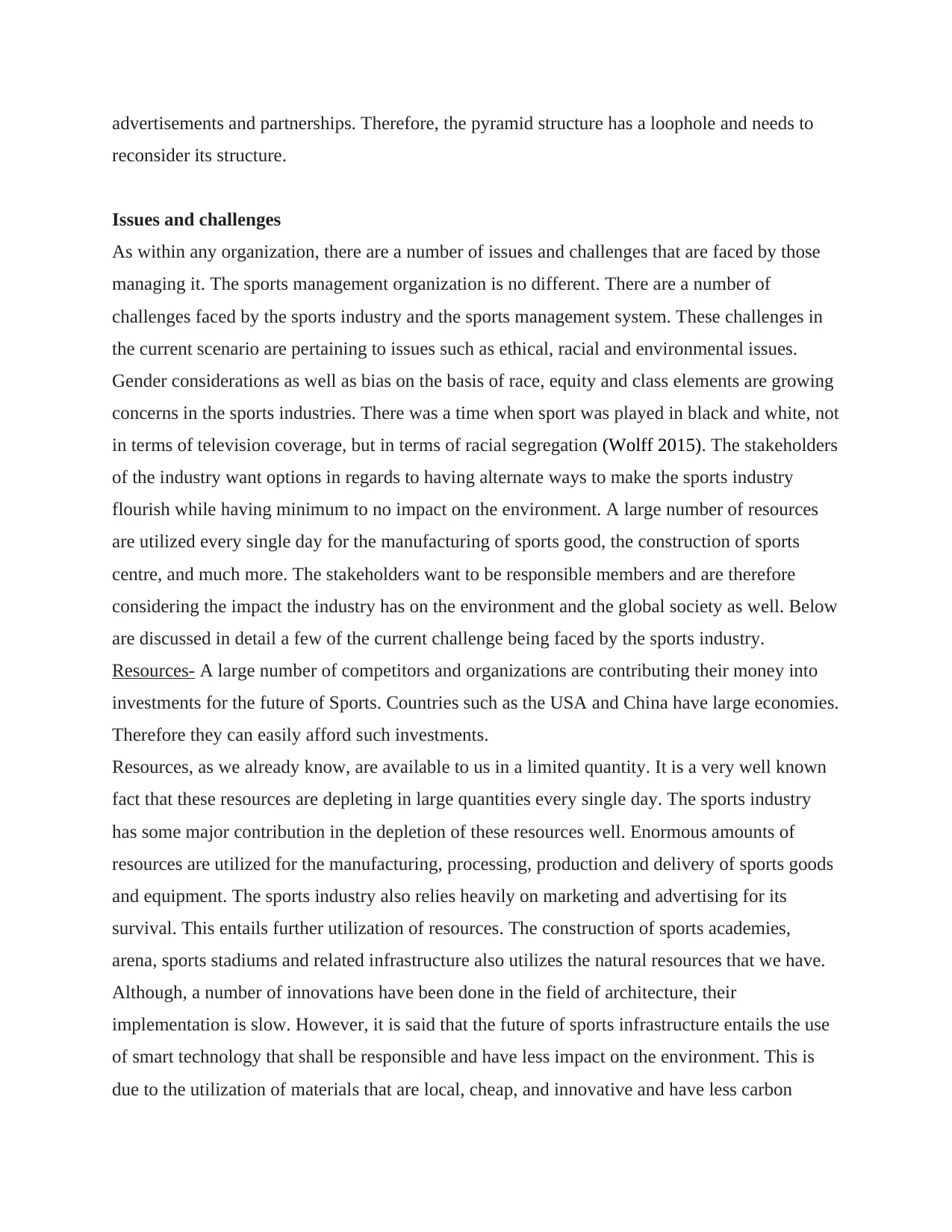
advertisements and partnerships. Therefore, the pyramid structure has a loophole and needs to
reconsider its structure.
Issues and challenges
As within any organization, there are a number of issues and challenges that are faced by those
managing it. The sports management organization is no different. There are a number of
challenges faced by the sports industry and the sports management system. These challenges in
the current scenario are pertaining to issues such as ethical, racial and environmental issues.
Gender considerations as well as bias on the basis of race, equity and class elements are growing
concerns in the sports industries. There was a time when sport was played in black and white, not
in terms of television coverage, but in terms of racial segregation (Wolff 2015). The stakeholders
of the industry want options in regards to having alternate ways to make the sports industry
flourish while having minimum to no impact on the environment. A large number of resources
are utilized every single day for the manufacturing of sports good, the construction of sports
centre, and much more. The stakeholders want to be responsible members and are therefore
considering the impact the industry has on the environment and the global society as well. Below
are discussed in detail a few of the current challenge being faced by the sports industry.
Resources- A large number of competitors and organizations are contributing their money into
investments for the future of Sports. Countries such as the USA and China have large economies.
Therefore they can easily afford such investments.
Resources, as we already know, are available to us in a limited quantity. It is a very well known
fact that these resources are depleting in large quantities every single day. The sports industry
has some major contribution in the depletion of these resources well. Enormous amounts of
resources are utilized for the manufacturing, processing, production and delivery of sports goods
and equipment. The sports industry also relies heavily on marketing and advertising for its
survival. This entails further utilization of resources. The construction of sports academies,
arena, sports stadiums and related infrastructure also utilizes the natural resources that we have.
Although, a number of innovations have been done in the field of architecture, their
implementation is slow. However, it is said that the future of sports infrastructure entails the use
of smart technology that shall be responsible and have less impact on the environment. This is
due to the utilization of materials that are local, cheap, and innovative and have less carbon
reconsider its structure.
Issues and challenges
As within any organization, there are a number of issues and challenges that are faced by those
managing it. The sports management organization is no different. There are a number of
challenges faced by the sports industry and the sports management system. These challenges in
the current scenario are pertaining to issues such as ethical, racial and environmental issues.
Gender considerations as well as bias on the basis of race, equity and class elements are growing
concerns in the sports industries. There was a time when sport was played in black and white, not
in terms of television coverage, but in terms of racial segregation (Wolff 2015). The stakeholders
of the industry want options in regards to having alternate ways to make the sports industry
flourish while having minimum to no impact on the environment. A large number of resources
are utilized every single day for the manufacturing of sports good, the construction of sports
centre, and much more. The stakeholders want to be responsible members and are therefore
considering the impact the industry has on the environment and the global society as well. Below
are discussed in detail a few of the current challenge being faced by the sports industry.
Resources- A large number of competitors and organizations are contributing their money into
investments for the future of Sports. Countries such as the USA and China have large economies.
Therefore they can easily afford such investments.
Resources, as we already know, are available to us in a limited quantity. It is a very well known
fact that these resources are depleting in large quantities every single day. The sports industry
has some major contribution in the depletion of these resources well. Enormous amounts of
resources are utilized for the manufacturing, processing, production and delivery of sports goods
and equipment. The sports industry also relies heavily on marketing and advertising for its
survival. This entails further utilization of resources. The construction of sports academies,
arena, sports stadiums and related infrastructure also utilizes the natural resources that we have.
Although, a number of innovations have been done in the field of architecture, their
implementation is slow. However, it is said that the future of sports infrastructure entails the use
of smart technology that shall be responsible and have less impact on the environment. This is
due to the utilization of materials that are local, cheap, and innovative and have less carbon
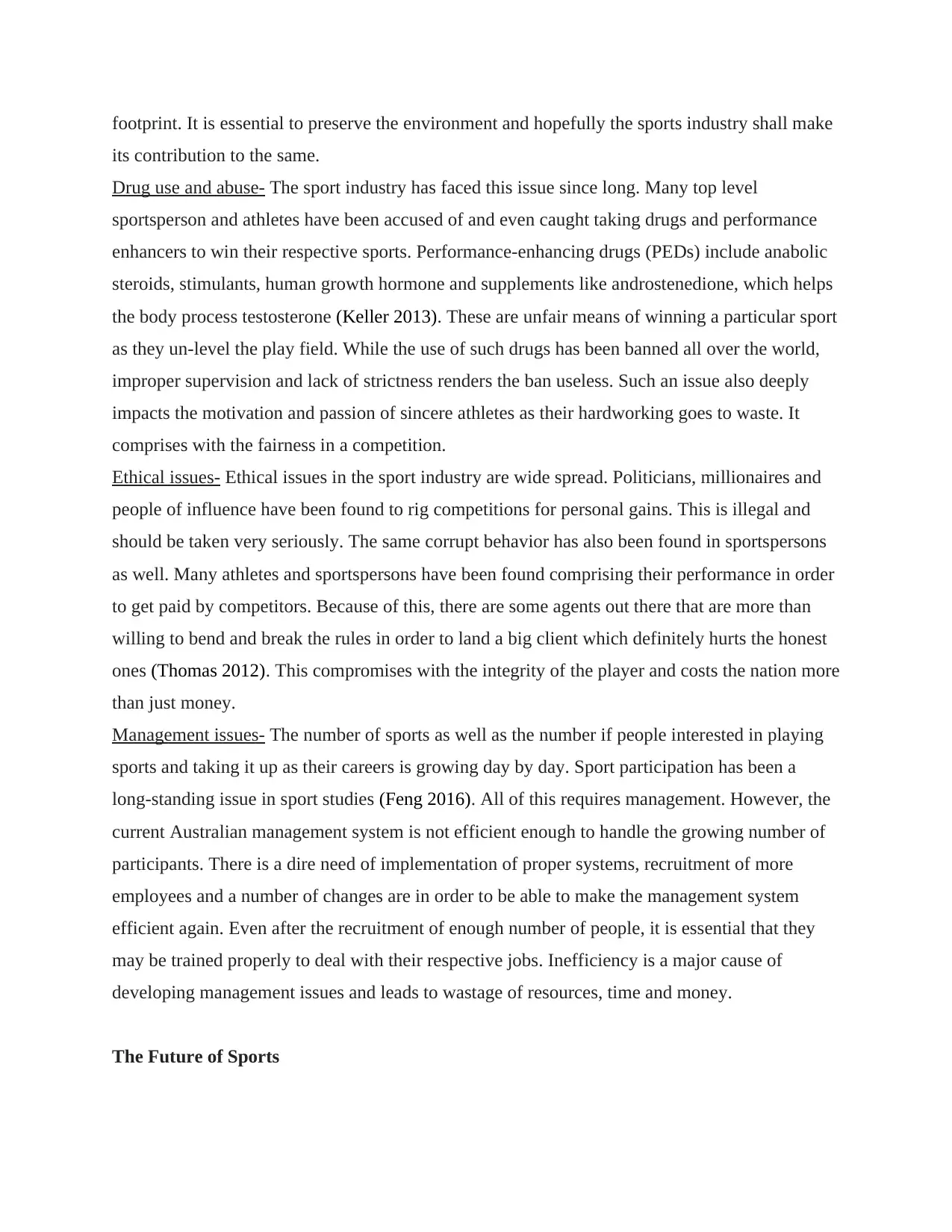
footprint. It is essential to preserve the environment and hopefully the sports industry shall make
its contribution to the same.
Drug use and abuse- The sport industry has faced this issue since long. Many top level
sportsperson and athletes have been accused of and even caught taking drugs and performance
enhancers to win their respective sports. Performance-enhancing drugs (PEDs) include anabolic
steroids, stimulants, human growth hormone and supplements like androstenedione, which helps
the body process testosterone (Keller 2013). These are unfair means of winning a particular sport
as they un-level the play field. While the use of such drugs has been banned all over the world,
improper supervision and lack of strictness renders the ban useless. Such an issue also deeply
impacts the motivation and passion of sincere athletes as their hardworking goes to waste. It
comprises with the fairness in a competition.
Ethical issues- Ethical issues in the sport industry are wide spread. Politicians, millionaires and
people of influence have been found to rig competitions for personal gains. This is illegal and
should be taken very seriously. The same corrupt behavior has also been found in sportspersons
as well. Many athletes and sportspersons have been found comprising their performance in order
to get paid by competitors. Because of this, there are some agents out there that are more than
willing to bend and break the rules in order to land a big client which definitely hurts the honest
ones (Thomas 2012). This compromises with the integrity of the player and costs the nation more
than just money.
Management issues- The number of sports as well as the number if people interested in playing
sports and taking it up as their careers is growing day by day. Sport participation has been a
long-standing issue in sport studies (Feng 2016). All of this requires management. However, the
current Australian management system is not efficient enough to handle the growing number of
participants. There is a dire need of implementation of proper systems, recruitment of more
employees and a number of changes are in order to be able to make the management system
efficient again. Even after the recruitment of enough number of people, it is essential that they
may be trained properly to deal with their respective jobs. Inefficiency is a major cause of
developing management issues and leads to wastage of resources, time and money.
The Future of Sports
its contribution to the same.
Drug use and abuse- The sport industry has faced this issue since long. Many top level
sportsperson and athletes have been accused of and even caught taking drugs and performance
enhancers to win their respective sports. Performance-enhancing drugs (PEDs) include anabolic
steroids, stimulants, human growth hormone and supplements like androstenedione, which helps
the body process testosterone (Keller 2013). These are unfair means of winning a particular sport
as they un-level the play field. While the use of such drugs has been banned all over the world,
improper supervision and lack of strictness renders the ban useless. Such an issue also deeply
impacts the motivation and passion of sincere athletes as their hardworking goes to waste. It
comprises with the fairness in a competition.
Ethical issues- Ethical issues in the sport industry are wide spread. Politicians, millionaires and
people of influence have been found to rig competitions for personal gains. This is illegal and
should be taken very seriously. The same corrupt behavior has also been found in sportspersons
as well. Many athletes and sportspersons have been found comprising their performance in order
to get paid by competitors. Because of this, there are some agents out there that are more than
willing to bend and break the rules in order to land a big client which definitely hurts the honest
ones (Thomas 2012). This compromises with the integrity of the player and costs the nation more
than just money.
Management issues- The number of sports as well as the number if people interested in playing
sports and taking it up as their careers is growing day by day. Sport participation has been a
long-standing issue in sport studies (Feng 2016). All of this requires management. However, the
current Australian management system is not efficient enough to handle the growing number of
participants. There is a dire need of implementation of proper systems, recruitment of more
employees and a number of changes are in order to be able to make the management system
efficient again. Even after the recruitment of enough number of people, it is essential that they
may be trained properly to deal with their respective jobs. Inefficiency is a major cause of
developing management issues and leads to wastage of resources, time and money.
The Future of Sports
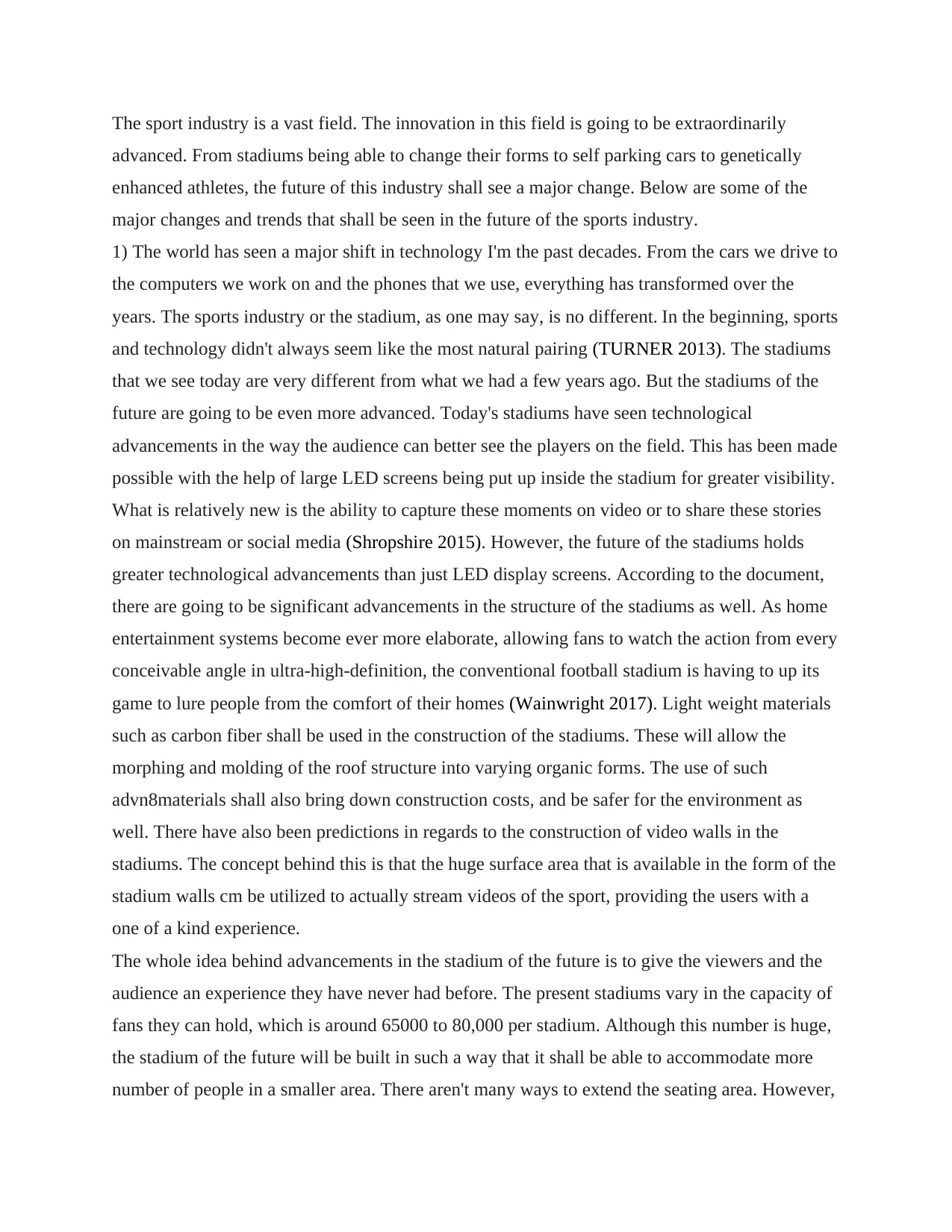
The sport industry is a vast field. The innovation in this field is going to be extraordinarily
advanced. From stadiums being able to change their forms to self parking cars to genetically
enhanced athletes, the future of this industry shall see a major change. Below are some of the
major changes and trends that shall be seen in the future of the sports industry.
1) The world has seen a major shift in technology I'm the past decades. From the cars we drive to
the computers we work on and the phones that we use, everything has transformed over the
years. The sports industry or the stadium, as one may say, is no different. In the beginning, sports
and technology didn't always seem like the most natural pairing (TURNER 2013). The stadiums
that we see today are very different from what we had a few years ago. But the stadiums of the
future are going to be even more advanced. Today's stadiums have seen technological
advancements in the way the audience can better see the players on the field. This has been made
possible with the help of large LED screens being put up inside the stadium for greater visibility.
What is relatively new is the ability to capture these moments on video or to share these stories
on mainstream or social media (Shropshire 2015). However, the future of the stadiums holds
greater technological advancements than just LED display screens. According to the document,
there are going to be significant advancements in the structure of the stadiums as well. As home
entertainment systems become ever more elaborate, allowing fans to watch the action from every
conceivable angle in ultra-high-definition, the conventional football stadium is having to up its
game to lure people from the comfort of their homes (Wainwright 2017). Light weight materials
such as carbon fiber shall be used in the construction of the stadiums. These will allow the
morphing and molding of the roof structure into varying organic forms. The use of such
advn8materials shall also bring down construction costs, and be safer for the environment as
well. There have also been predictions in regards to the construction of video walls in the
stadiums. The concept behind this is that the huge surface area that is available in the form of the
stadium walls cm be utilized to actually stream videos of the sport, providing the users with a
one of a kind experience.
The whole idea behind advancements in the stadium of the future is to give the viewers and the
audience an experience they have never had before. The present stadiums vary in the capacity of
fans they can hold, which is around 65000 to 80,000 per stadium. Although this number is huge,
the stadium of the future will be built in such a way that it shall be able to accommodate more
number of people in a smaller area. There aren't many ways to extend the seating area. However,
advanced. From stadiums being able to change their forms to self parking cars to genetically
enhanced athletes, the future of this industry shall see a major change. Below are some of the
major changes and trends that shall be seen in the future of the sports industry.
1) The world has seen a major shift in technology I'm the past decades. From the cars we drive to
the computers we work on and the phones that we use, everything has transformed over the
years. The sports industry or the stadium, as one may say, is no different. In the beginning, sports
and technology didn't always seem like the most natural pairing (TURNER 2013). The stadiums
that we see today are very different from what we had a few years ago. But the stadiums of the
future are going to be even more advanced. Today's stadiums have seen technological
advancements in the way the audience can better see the players on the field. This has been made
possible with the help of large LED screens being put up inside the stadium for greater visibility.
What is relatively new is the ability to capture these moments on video or to share these stories
on mainstream or social media (Shropshire 2015). However, the future of the stadiums holds
greater technological advancements than just LED display screens. According to the document,
there are going to be significant advancements in the structure of the stadiums as well. As home
entertainment systems become ever more elaborate, allowing fans to watch the action from every
conceivable angle in ultra-high-definition, the conventional football stadium is having to up its
game to lure people from the comfort of their homes (Wainwright 2017). Light weight materials
such as carbon fiber shall be used in the construction of the stadiums. These will allow the
morphing and molding of the roof structure into varying organic forms. The use of such
advn8materials shall also bring down construction costs, and be safer for the environment as
well. There have also been predictions in regards to the construction of video walls in the
stadiums. The concept behind this is that the huge surface area that is available in the form of the
stadium walls cm be utilized to actually stream videos of the sport, providing the users with a
one of a kind experience.
The whole idea behind advancements in the stadium of the future is to give the viewers and the
audience an experience they have never had before. The present stadiums vary in the capacity of
fans they can hold, which is around 65000 to 80,000 per stadium. Although this number is huge,
the stadium of the future will be built in such a way that it shall be able to accommodate more
number of people in a smaller area. There aren't many ways to extend the seating area. However,
Paraphrase This Document
Need a fresh take? Get an instant paraphrase of this document with our AI Paraphraser
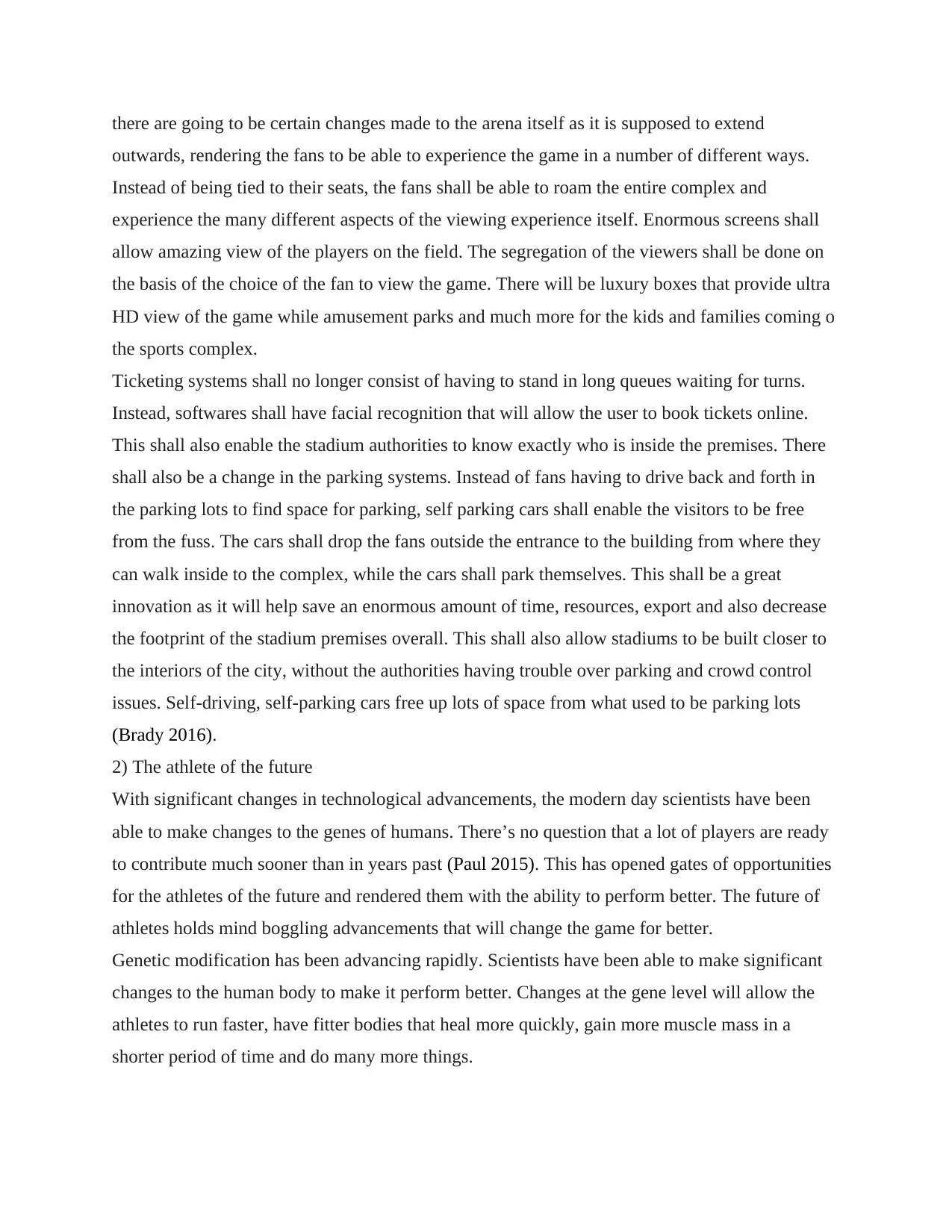
there are going to be certain changes made to the arena itself as it is supposed to extend
outwards, rendering the fans to be able to experience the game in a number of different ways.
Instead of being tied to their seats, the fans shall be able to roam the entire complex and
experience the many different aspects of the viewing experience itself. Enormous screens shall
allow amazing view of the players on the field. The segregation of the viewers shall be done on
the basis of the choice of the fan to view the game. There will be luxury boxes that provide ultra
HD view of the game while amusement parks and much more for the kids and families coming o
the sports complex.
Ticketing systems shall no longer consist of having to stand in long queues waiting for turns.
Instead, softwares shall have facial recognition that will allow the user to book tickets online.
This shall also enable the stadium authorities to know exactly who is inside the premises. There
shall also be a change in the parking systems. Instead of fans having to drive back and forth in
the parking lots to find space for parking, self parking cars shall enable the visitors to be free
from the fuss. The cars shall drop the fans outside the entrance to the building from where they
can walk inside to the complex, while the cars shall park themselves. This shall be a great
innovation as it will help save an enormous amount of time, resources, export and also decrease
the footprint of the stadium premises overall. This shall also allow stadiums to be built closer to
the interiors of the city, without the authorities having trouble over parking and crowd control
issues. Self-driving, self-parking cars free up lots of space from what used to be parking lots
(Brady 2016).
2) The athlete of the future
With significant changes in technological advancements, the modern day scientists have been
able to make changes to the genes of humans. There’s no question that a lot of players are ready
to contribute much sooner than in years past (Paul 2015). This has opened gates of opportunities
for the athletes of the future and rendered them with the ability to perform better. The future of
athletes holds mind boggling advancements that will change the game for better.
Genetic modification has been advancing rapidly. Scientists have been able to make significant
changes to the human body to make it perform better. Changes at the gene level will allow the
athletes to run faster, have fitter bodies that heal more quickly, gain more muscle mass in a
shorter period of time and do many more things.
outwards, rendering the fans to be able to experience the game in a number of different ways.
Instead of being tied to their seats, the fans shall be able to roam the entire complex and
experience the many different aspects of the viewing experience itself. Enormous screens shall
allow amazing view of the players on the field. The segregation of the viewers shall be done on
the basis of the choice of the fan to view the game. There will be luxury boxes that provide ultra
HD view of the game while amusement parks and much more for the kids and families coming o
the sports complex.
Ticketing systems shall no longer consist of having to stand in long queues waiting for turns.
Instead, softwares shall have facial recognition that will allow the user to book tickets online.
This shall also enable the stadium authorities to know exactly who is inside the premises. There
shall also be a change in the parking systems. Instead of fans having to drive back and forth in
the parking lots to find space for parking, self parking cars shall enable the visitors to be free
from the fuss. The cars shall drop the fans outside the entrance to the building from where they
can walk inside to the complex, while the cars shall park themselves. This shall be a great
innovation as it will help save an enormous amount of time, resources, export and also decrease
the footprint of the stadium premises overall. This shall also allow stadiums to be built closer to
the interiors of the city, without the authorities having trouble over parking and crowd control
issues. Self-driving, self-parking cars free up lots of space from what used to be parking lots
(Brady 2016).
2) The athlete of the future
With significant changes in technological advancements, the modern day scientists have been
able to make changes to the genes of humans. There’s no question that a lot of players are ready
to contribute much sooner than in years past (Paul 2015). This has opened gates of opportunities
for the athletes of the future and rendered them with the ability to perform better. The future of
athletes holds mind boggling advancements that will change the game for better.
Genetic modification has been advancing rapidly. Scientists have been able to make significant
changes to the human body to make it perform better. Changes at the gene level will allow the
athletes to run faster, have fitter bodies that heal more quickly, gain more muscle mass in a
shorter period of time and do many more things.

Today's athletes are guilty of using doping methods to enhance their performance. And while,
the doping does allow them to perform better, not only is it illegal, but it also significantly
impact the overall health of the athlete. With gene modification, this is not the case. Gene
modification allows a legal and safe way for the athlete to have slight changes in his body which
shall have enhance the physiological aspect of his bodily functions. Different types of genes are
responsible for different factors. Small changes shall allow bigger differences in performance.
For example, a change to the gene by the name 'EpoR' shall increase the number of red blood
cells in the athlete’s body. This will lead to greater amount of oxygen available to the heart.
Another example of the modification to the SCN9Agene, which shall block the nerve pathways,
will enable the athlete to feel less or no pain in case of small injuries. Another modification in
the ACE gene shall allow the human body to climb to a height of 8000 meters without requiring
oxygen. Scientists have also discovered that when they disable the MSTN gene, the human body
is able to gain double the muscle mass in the same amount t of time. Alterations to the PEPCK
gene allow the human body to run for 60 percent longer time periods as it burns the fatty acids
and utilizes this energy. This also does not produce and lactic acid which tends to slow the body
down. Another gene LRP5 can be modified to strengthen the bone and make them unbreakable
by increasing the bone density.
All of this and much more is possible by genetic modification. The scientists already have the
technology for the implementation of some if these changes, while some other require more
research and in depth study. However, amazing things are possible in the future of the athletes.
Scientists have already been able to re-grow body parts such as ears nose fingers etc. This is not
the technology of the future but that of the present. In the future, however, things might even be
more advanced. Scientists are already working on what they're call fracture putty. This shall
allow broken bones to be healed within a matter of days as opposed to weeks. Also, they're able
to replicate artificial organs to such finesse that one cannot tell the difference between natural
and artificial body parts anymore.
3) Innovation in delivery system
Changes in the delivery system of the sports industry are in order. Efficient use of resources has
already begun. With the help of technological advancements, more and more people shall be able
to enjoy their favorite sports without comprising with the already devastated condition of the
environment. Resources put to good use shall be able to give back to the planet in ways which
the doping does allow them to perform better, not only is it illegal, but it also significantly
impact the overall health of the athlete. With gene modification, this is not the case. Gene
modification allows a legal and safe way for the athlete to have slight changes in his body which
shall have enhance the physiological aspect of his bodily functions. Different types of genes are
responsible for different factors. Small changes shall allow bigger differences in performance.
For example, a change to the gene by the name 'EpoR' shall increase the number of red blood
cells in the athlete’s body. This will lead to greater amount of oxygen available to the heart.
Another example of the modification to the SCN9Agene, which shall block the nerve pathways,
will enable the athlete to feel less or no pain in case of small injuries. Another modification in
the ACE gene shall allow the human body to climb to a height of 8000 meters without requiring
oxygen. Scientists have also discovered that when they disable the MSTN gene, the human body
is able to gain double the muscle mass in the same amount t of time. Alterations to the PEPCK
gene allow the human body to run for 60 percent longer time periods as it burns the fatty acids
and utilizes this energy. This also does not produce and lactic acid which tends to slow the body
down. Another gene LRP5 can be modified to strengthen the bone and make them unbreakable
by increasing the bone density.
All of this and much more is possible by genetic modification. The scientists already have the
technology for the implementation of some if these changes, while some other require more
research and in depth study. However, amazing things are possible in the future of the athletes.
Scientists have already been able to re-grow body parts such as ears nose fingers etc. This is not
the technology of the future but that of the present. In the future, however, things might even be
more advanced. Scientists are already working on what they're call fracture putty. This shall
allow broken bones to be healed within a matter of days as opposed to weeks. Also, they're able
to replicate artificial organs to such finesse that one cannot tell the difference between natural
and artificial body parts anymore.
3) Innovation in delivery system
Changes in the delivery system of the sports industry are in order. Efficient use of resources has
already begun. With the help of technological advancements, more and more people shall be able
to enjoy their favorite sports without comprising with the already devastated condition of the
environment. Resources put to good use shall be able to give back to the planet in ways which
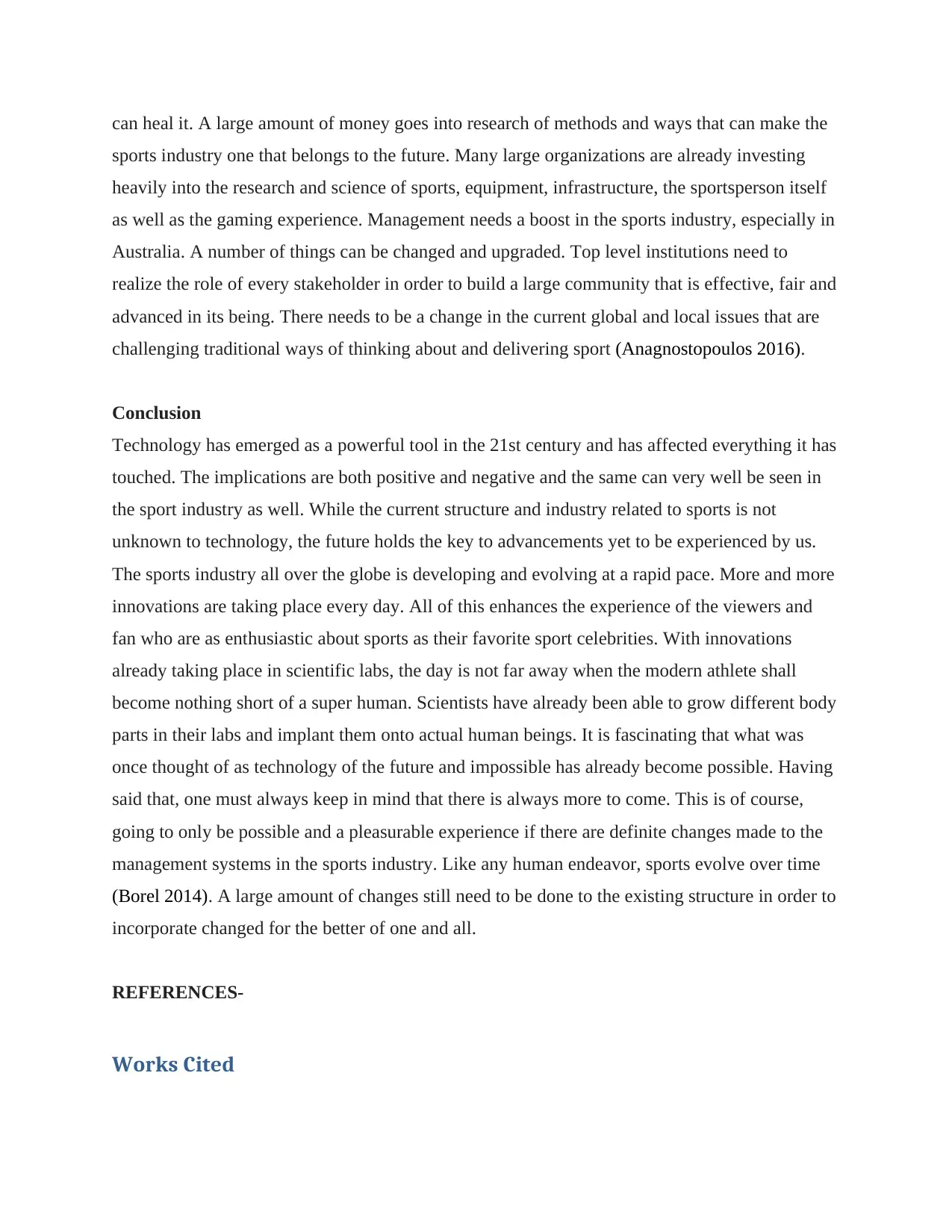
can heal it. A large amount of money goes into research of methods and ways that can make the
sports industry one that belongs to the future. Many large organizations are already investing
heavily into the research and science of sports, equipment, infrastructure, the sportsperson itself
as well as the gaming experience. Management needs a boost in the sports industry, especially in
Australia. A number of things can be changed and upgraded. Top level institutions need to
realize the role of every stakeholder in order to build a large community that is effective, fair and
advanced in its being. There needs to be a change in the current global and local issues that are
challenging traditional ways of thinking about and delivering sport (Anagnostopoulos 2016).
Conclusion
Technology has emerged as a powerful tool in the 21st century and has affected everything it has
touched. The implications are both positive and negative and the same can very well be seen in
the sport industry as well. While the current structure and industry related to sports is not
unknown to technology, the future holds the key to advancements yet to be experienced by us.
The sports industry all over the globe is developing and evolving at a rapid pace. More and more
innovations are taking place every day. All of this enhances the experience of the viewers and
fan who are as enthusiastic about sports as their favorite sport celebrities. With innovations
already taking place in scientific labs, the day is not far away when the modern athlete shall
become nothing short of a super human. Scientists have already been able to grow different body
parts in their labs and implant them onto actual human beings. It is fascinating that what was
once thought of as technology of the future and impossible has already become possible. Having
said that, one must always keep in mind that there is always more to come. This is of course,
going to only be possible and a pleasurable experience if there are definite changes made to the
management systems in the sports industry. Like any human endeavor, sports evolve over time
(Borel 2014). A large amount of changes still need to be done to the existing structure in order to
incorporate changed for the better of one and all.
REFERENCES-
Works Cited
sports industry one that belongs to the future. Many large organizations are already investing
heavily into the research and science of sports, equipment, infrastructure, the sportsperson itself
as well as the gaming experience. Management needs a boost in the sports industry, especially in
Australia. A number of things can be changed and upgraded. Top level institutions need to
realize the role of every stakeholder in order to build a large community that is effective, fair and
advanced in its being. There needs to be a change in the current global and local issues that are
challenging traditional ways of thinking about and delivering sport (Anagnostopoulos 2016).
Conclusion
Technology has emerged as a powerful tool in the 21st century and has affected everything it has
touched. The implications are both positive and negative and the same can very well be seen in
the sport industry as well. While the current structure and industry related to sports is not
unknown to technology, the future holds the key to advancements yet to be experienced by us.
The sports industry all over the globe is developing and evolving at a rapid pace. More and more
innovations are taking place every day. All of this enhances the experience of the viewers and
fan who are as enthusiastic about sports as their favorite sport celebrities. With innovations
already taking place in scientific labs, the day is not far away when the modern athlete shall
become nothing short of a super human. Scientists have already been able to grow different body
parts in their labs and implant them onto actual human beings. It is fascinating that what was
once thought of as technology of the future and impossible has already become possible. Having
said that, one must always keep in mind that there is always more to come. This is of course,
going to only be possible and a pleasurable experience if there are definite changes made to the
management systems in the sports industry. Like any human endeavor, sports evolve over time
(Borel 2014). A large amount of changes still need to be done to the existing structure in order to
incorporate changed for the better of one and all.
REFERENCES-
Works Cited
Secure Best Marks with AI Grader
Need help grading? Try our AI Grader for instant feedback on your assignments.
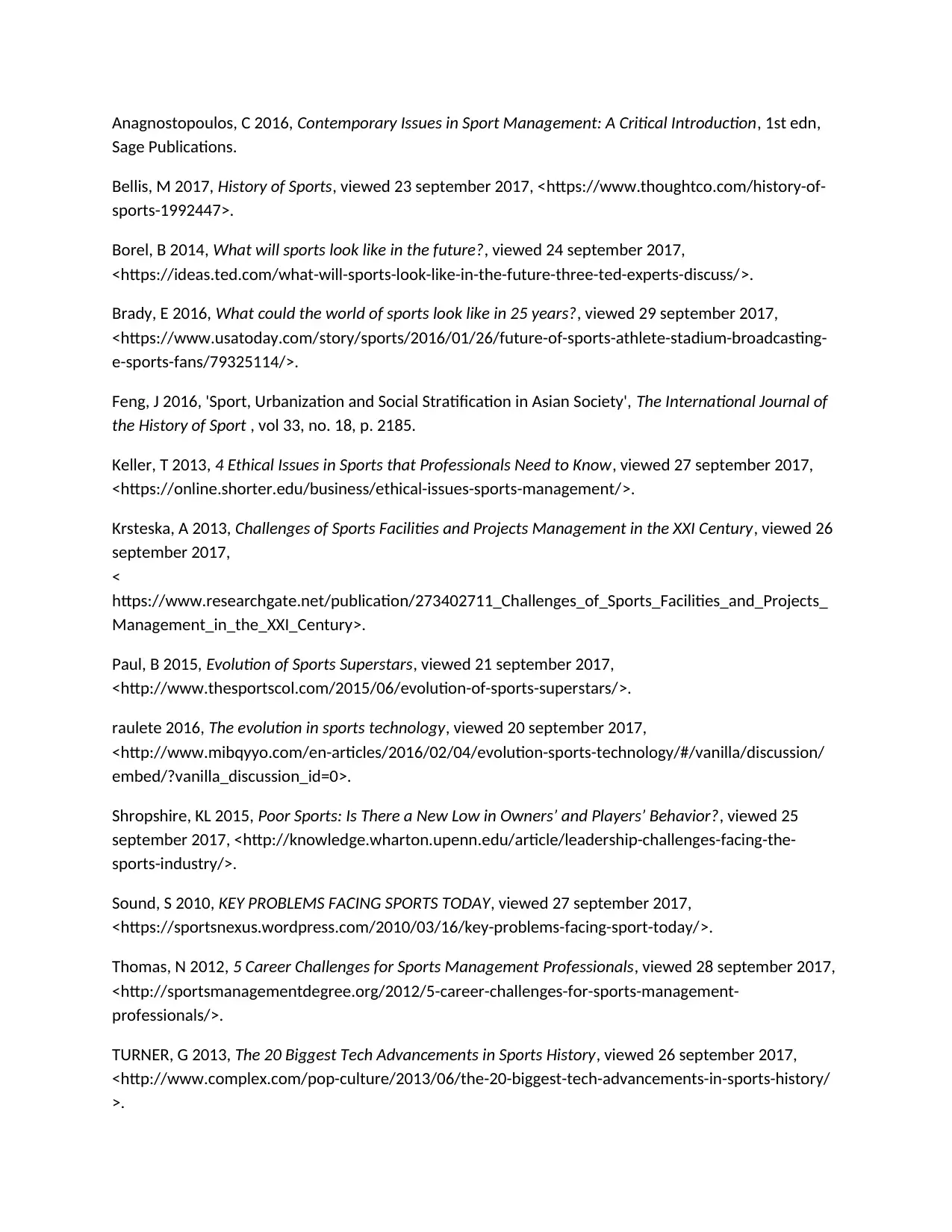
Anagnostopoulos, C 2016, Contemporary Issues in Sport Management: A Critical Introduction, 1st edn,
Sage Publications.
Bellis, M 2017, History of Sports, viewed 23 september 2017, <https://www.thoughtco.com/history-of-
sports-1992447>.
Borel, B 2014, What will sports look like in the future?, viewed 24 september 2017,
<https://ideas.ted.com/what-will-sports-look-like-in-the-future-three-ted-experts-discuss/>.
Brady, E 2016, What could the world of sports look like in 25 years?, viewed 29 september 2017,
<https://www.usatoday.com/story/sports/2016/01/26/future-of-sports-athlete-stadium-broadcasting-
e-sports-fans/79325114/>.
Feng, J 2016, 'Sport, Urbanization and Social Stratification in Asian Society', The International Journal of
the History of Sport , vol 33, no. 18, p. 2185.
Keller, T 2013, 4 Ethical Issues in Sports that Professionals Need to Know, viewed 27 september 2017,
<https://online.shorter.edu/business/ethical-issues-sports-management/>.
Krsteska, A 2013, Challenges of Sports Facilities and Projects Management in the XXI Century, viewed 26
september 2017,
<
https://www.researchgate.net/publication/273402711_Challenges_of_Sports_Facilities_and_Projects_
Management_in_the_XXI_Century>.
Paul, B 2015, Evolution of Sports Superstars, viewed 21 september 2017,
<http://www.thesportscol.com/2015/06/evolution-of-sports-superstars/>.
raulete 2016, The evolution in sports technology, viewed 20 september 2017,
<http://www.mibqyyo.com/en-articles/2016/02/04/evolution-sports-technology/#/vanilla/discussion/
embed/?vanilla_discussion_id=0>.
Shropshire, KL 2015, Poor Sports: Is There a New Low in Owners’ and Players’ Behavior?, viewed 25
september 2017, <http://knowledge.wharton.upenn.edu/article/leadership-challenges-facing-the-
sports-industry/>.
Sound, S 2010, KEY PROBLEMS FACING SPORTS TODAY, viewed 27 september 2017,
<https://sportsnexus.wordpress.com/2010/03/16/key-problems-facing-sport-today/>.
Thomas, N 2012, 5 Career Challenges for Sports Management Professionals, viewed 28 september 2017,
<http://sportsmanagementdegree.org/2012/5-career-challenges-for-sports-management-
professionals/>.
TURNER, G 2013, The 20 Biggest Tech Advancements in Sports History, viewed 26 september 2017,
<http://www.complex.com/pop-culture/2013/06/the-20-biggest-tech-advancements-in-sports-history/
>.
Sage Publications.
Bellis, M 2017, History of Sports, viewed 23 september 2017, <https://www.thoughtco.com/history-of-
sports-1992447>.
Borel, B 2014, What will sports look like in the future?, viewed 24 september 2017,
<https://ideas.ted.com/what-will-sports-look-like-in-the-future-three-ted-experts-discuss/>.
Brady, E 2016, What could the world of sports look like in 25 years?, viewed 29 september 2017,
<https://www.usatoday.com/story/sports/2016/01/26/future-of-sports-athlete-stadium-broadcasting-
e-sports-fans/79325114/>.
Feng, J 2016, 'Sport, Urbanization and Social Stratification in Asian Society', The International Journal of
the History of Sport , vol 33, no. 18, p. 2185.
Keller, T 2013, 4 Ethical Issues in Sports that Professionals Need to Know, viewed 27 september 2017,
<https://online.shorter.edu/business/ethical-issues-sports-management/>.
Krsteska, A 2013, Challenges of Sports Facilities and Projects Management in the XXI Century, viewed 26
september 2017,
<
https://www.researchgate.net/publication/273402711_Challenges_of_Sports_Facilities_and_Projects_
Management_in_the_XXI_Century>.
Paul, B 2015, Evolution of Sports Superstars, viewed 21 september 2017,
<http://www.thesportscol.com/2015/06/evolution-of-sports-superstars/>.
raulete 2016, The evolution in sports technology, viewed 20 september 2017,
<http://www.mibqyyo.com/en-articles/2016/02/04/evolution-sports-technology/#/vanilla/discussion/
embed/?vanilla_discussion_id=0>.
Shropshire, KL 2015, Poor Sports: Is There a New Low in Owners’ and Players’ Behavior?, viewed 25
september 2017, <http://knowledge.wharton.upenn.edu/article/leadership-challenges-facing-the-
sports-industry/>.
Sound, S 2010, KEY PROBLEMS FACING SPORTS TODAY, viewed 27 september 2017,
<https://sportsnexus.wordpress.com/2010/03/16/key-problems-facing-sport-today/>.
Thomas, N 2012, 5 Career Challenges for Sports Management Professionals, viewed 28 september 2017,
<http://sportsmanagementdegree.org/2012/5-career-challenges-for-sports-management-
professionals/>.
TURNER, G 2013, The 20 Biggest Tech Advancements in Sports History, viewed 26 september 2017,
<http://www.complex.com/pop-culture/2013/06/the-20-biggest-tech-advancements-in-sports-history/
>.

Wainwright, O 2017, Stadiums of the future: a revolution for the fan experience in sport, viewed 26
september 2017, <https://www.theguardian.com/sport/2017/jun/15/stadiums-future-holograms-
drones-fan-experience>.
Wolff, EA 2015, The Future of Sport, viewed 26 september 2017, <http://www.huffingtonpost.com/eli-
wolff/the-future-of-sport_b_6244634.html>.
september 2017, <https://www.theguardian.com/sport/2017/jun/15/stadiums-future-holograms-
drones-fan-experience>.
Wolff, EA 2015, The Future of Sport, viewed 26 september 2017, <http://www.huffingtonpost.com/eli-
wolff/the-future-of-sport_b_6244634.html>.
1 out of 12
Your All-in-One AI-Powered Toolkit for Academic Success.
+13062052269
info@desklib.com
Available 24*7 on WhatsApp / Email
![[object Object]](/_next/static/media/star-bottom.7253800d.svg)
Unlock your academic potential
© 2024 | Zucol Services PVT LTD | All rights reserved.


